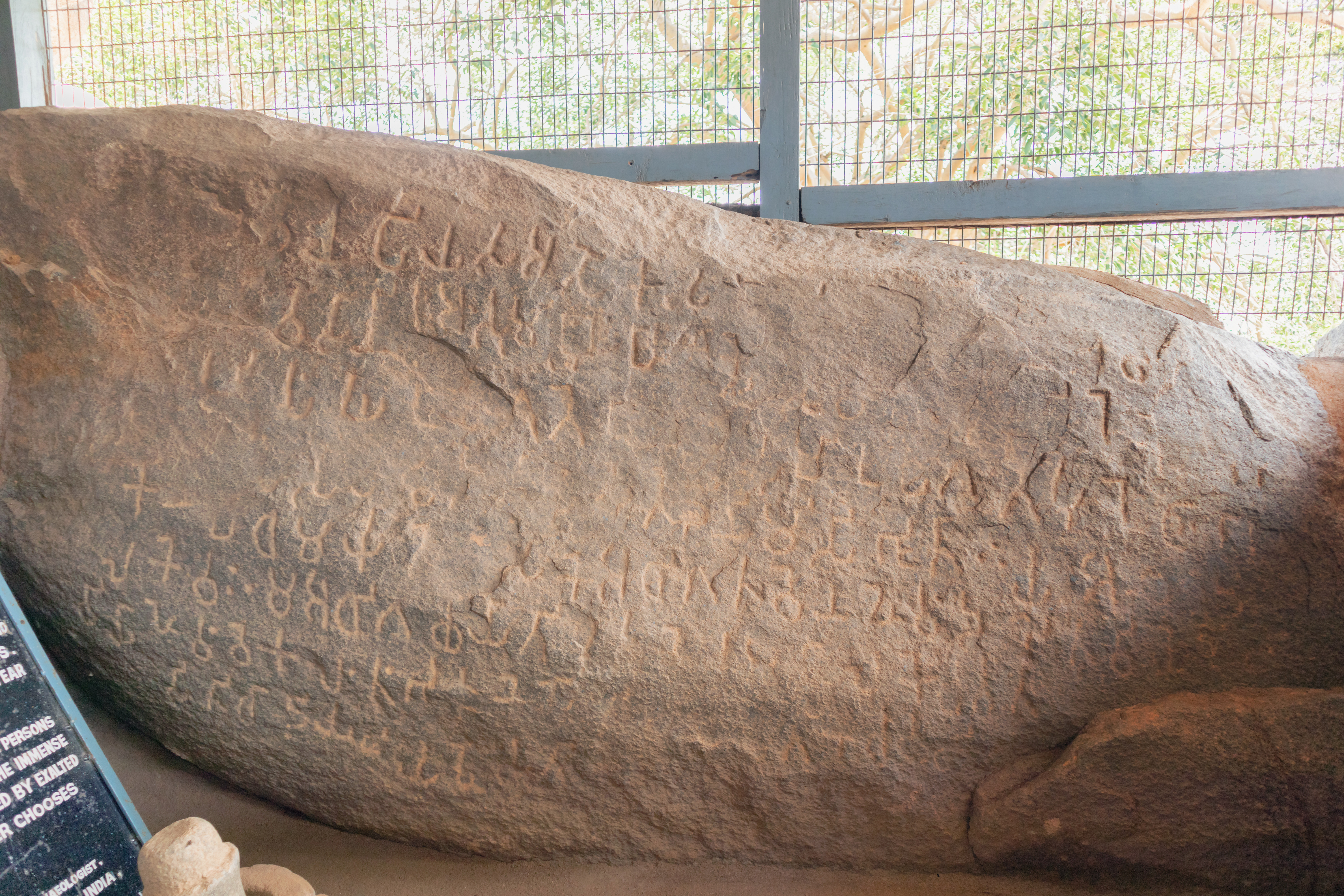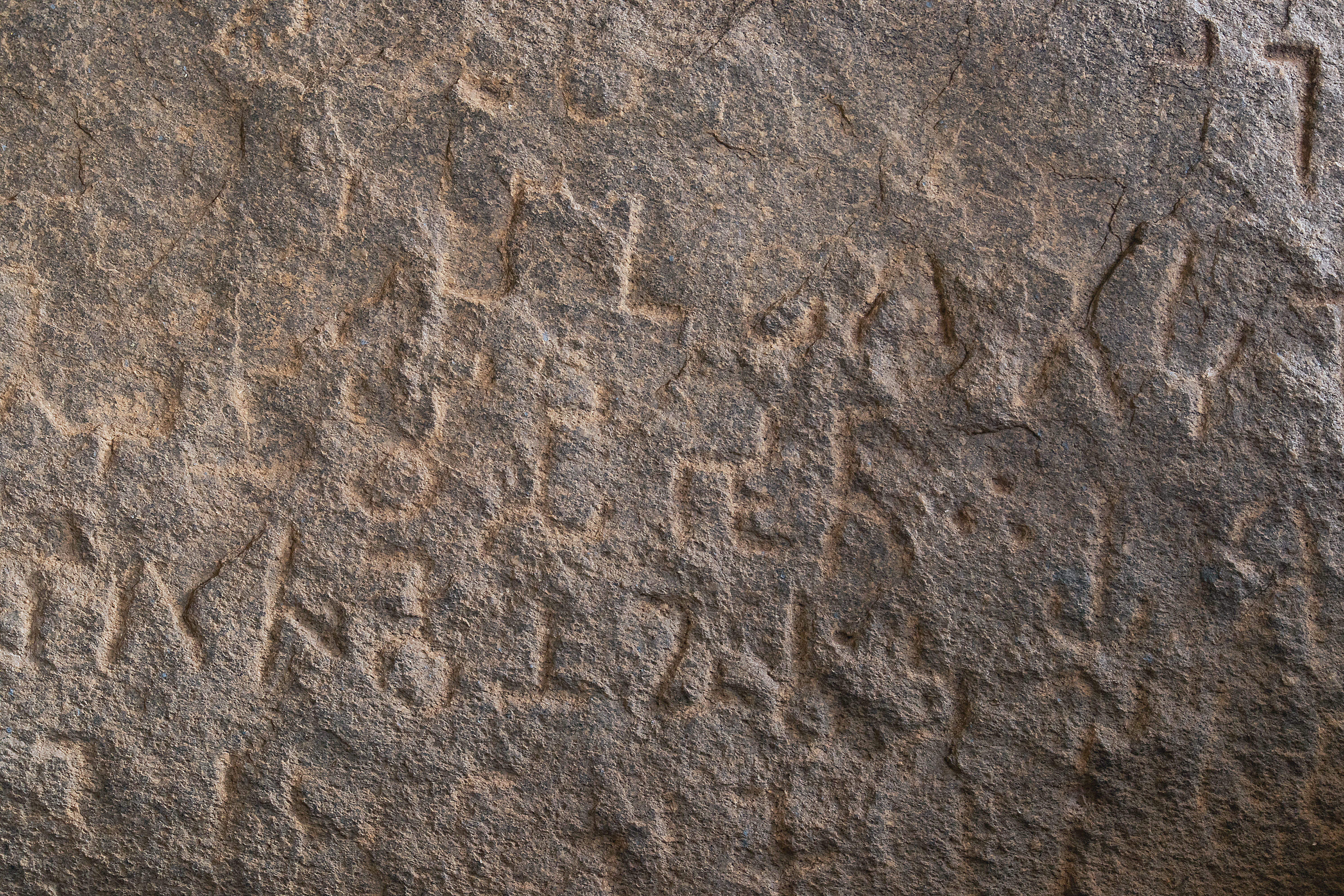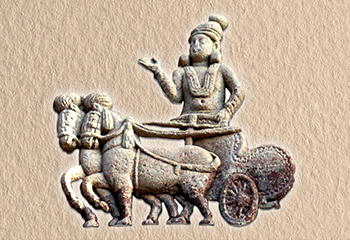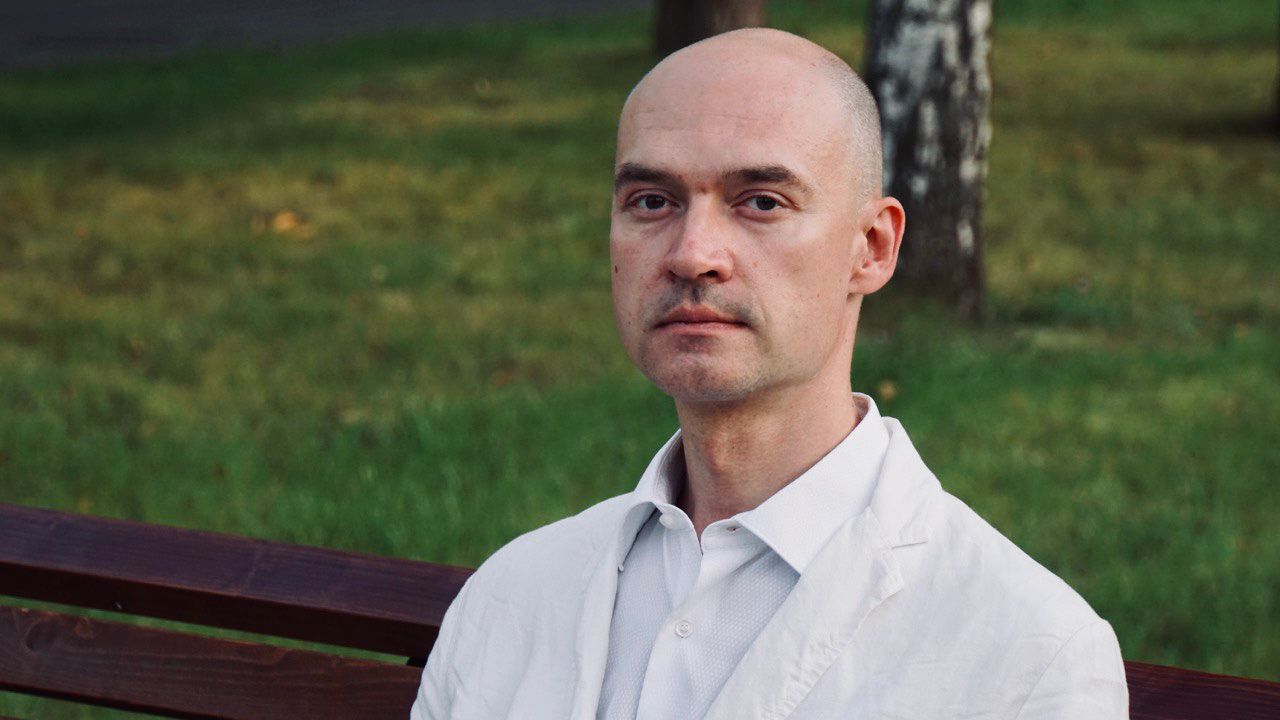Aśoka
- Region:
- South Asia
- Years of life:
- ? — 232/227 BC
AŚOKA (aśoka, Sanskrit — ‘(Born) without pain’ or ‘Without sorrow’) b. ? — 232/227 BC) — a king of the Mauryan dynasty of ancient India.
AŚOKA (aśoka, Sanskrit — ‘(Born) without pain’ or ‘Without sorrow’) b. ? — 232/227 BC) — a king of the Mauryan dynasty of ancient India.

Fig. 1a. The Rock Edict of Aśoka from Maski.
Photo: © WESTOCK PRODUCTIONS / Shutterstock.com

Fig. 1b. The Rock Edict of Aśoka from Maski.
Photo: © WESTOCK PRODUCTIONS / Shutterstock.com
Chronology
The time of Aśoka’s reign differs in Indology; 264–227 BC [Vigasin 2005: 594], 265–238 BC [Sen 2024].
Sources
The main reliable source of information about Aśoka are the inscriptions engraved on pillars and rocks that he and his apprentices have left behind (Fig. 1) [Hultsch 1925; Thapar 1961: 250–266; Vigasin 2007: 11–36]. Fourteen Major Rock Edicts, two Separate Rock Edicts and one Minor Rock Edict, seven Pillar Edicts — a total of over 150 copies of texts attributed to Aśoka has survived. The Minor Pillar Edicts include the Schism Edict, the Queen’s Edict, the Rummindei/Lumbini Edict, and the Nigali Sagar Edict (found in Nepal). Most of the edicts are written in Prakrits, the Middle Indic vernacular languages. Aśokan inscriptions found in northwestern India and Afghanistan are written in Aramaic and Ancient Greek.
In view of some scholars, Aśoka’s edicts were inspired by the inscriptions of the Achaemenid rulers of Persia and the Hellenistic sovereigns of the Middle East [Thapar 1961: 127–128; Vigasin 2005: 594].
The Narrative of Aśoka (Aśokāvadāna in Sanskrit), a legendary biography of Aśoka, is a part of Divyāvadāna or Divine Narrative, a Buddhist anthology in Sanskrit written not earlier than the 2nd century [Coleman, Elsner 1995: 173]. It describes Aśoka as a Buddhist universal ruler (chakravartin, Sanskrit — ‘the one who turns the wheel’), entirely devoted to spreading Buddhism, at times extreme cruel towards people of other faiths, or excessively generous towards the Buddhist community [Mitra 1882: 6–17; Przyluski 1923; Mukhopadhyaya 1960; Strong 1983]. Currently, Aśokāvadāna is considered an unreliable source [Thapar 1961: 9].
Some sources are written in Pāli: the Sinhala Buddhist poems Dīpavaṃsa or ‘Chronicle of the Island’ (4th–5th centuries) and Mahāvaṃsa or ‘The Great Chronicle’ (5th–6th centuries) [Oldenberg 1879; Geiger, Bode 1912; Law 1947; Vigasin 1984: 296; Guruge 1990; Frasch 2004: 70–81]. Regarded to be more reliable [Thapar 1961: 8], they often contradict each other; see Aśoka’s mother’s name discussion below. Sanskrit historical legends or puranas (purāṇa; ‘ancient, former’) give a relatively fair, though sometimes confusing, chronology of the reign of Aśoka and other Mauryan kings and provide a generalised image of the king [Thapar 1961: 9; Pargiter 1922; O’Flaherty 1993].
Some information about Aśoka is preserved in old Chinese written sources like the accounts of the Buddhist pilgrims Faxian (法顯) (5th century) and Xuanzang (玄奘) (7th century).
Biography
Aśoka was the son of Bindusara and the grandson of Chandragupta Maurya. According to the Matsyapurāṇa (272, 24), he ruled for 36 years [Vigasin 1990: 165]. His father ruled for 25 years according to the purana, for 28 years according to the Sinhala Chronicles, and for only 18 years according to the commentary to the 5th century Pāli canon Samantapāsādikā (Pāli ‘Entirely Pleasing’) written by Buddhaghosa [Law 1946: 15–16].
The exact year of Aśoka’s birth has not been established. His mother’s name is not known. According to the Aśokāvadāna, she was Subhadrāngi, the daughter of a Brahmin from the kingdom of Campā; according to Divyāvadāna her name was Janapadakalyani or Subhadrāngi, and in the Vaṃsatthapakāsinī, the commentary to the Sinhala Buddhist chronicle Mahāvaṃsa, she was called Dharma [Thapar 1961: 21; cf.: Lahiri 2015: 363].
According to a story in the Divyāvadāna anthology, Bindusara sent Aśoka to subdue a rebellion in the city of Taxila, but it had ended by the time the prince got there [Law 1946: 15; Thapar 1951: 21]. The Mahāvaṃsa mentions that Aśoka was the Viceroy of Ujjain, and this is supported by an inscription found during excavations in Saru Maru near the village of Pangoraria in Madhya Pradesh [Falk 1997: 119; Allen 2012: 154].
After Bindusara’s death, Aśoka killed all his brothers except Tissa and ruled for four years without coronation, according to the Samantapāsādikā. His coronation took place in Pataliputra [Law 1946: 16]. Aśoka was known as Devānaṃpiya Piyadāsi (Prakrit) or Devānāmpriya Priyadarśin (Sanskrit), i. e. ‘Beloved of the Gods’ and ‘One who looks with kindness upon everything’. Some scholars consider this a title, others believe it was the king’s given name [Monier-Williams 1899: 495, 710; Thapar 1961: 226–227; Vigasin 2007: 37–46].
The 13th Major Rock Edict states that Aśoka conquered the kingdom of Kalinga in the eighth year after his anointment (coronation), killing 100,000, causing death for another 100,000, and capturing 150,000. Feeling remorse, he began to spread dharma, a code of moral tenets. He sent emissaries to the Greek king Antiochus II Theos (‘Antiyoka’), Ptolemy II Philadelphus (‘Tulamaya’), Antigonus II Gonatas (‘Antikeni’), Magas of Cyrene (‘Maga’), Alexander (‘Alikasundara’), son of Pyrrhus of Epirus or son of Craterus of Corinth, and also to the Chola and Pandya kingdoms [Vigasin 2007: 22–23, 96–97].
As ‘King of Dharma’ Aśoka aimed to achieve a symbolic conquest of the universe [Vigasin 2005/2016; 2007: 106]. Aśoka regarded the propagation of dharma as his universal or ‘far-reaching’ victory. To achieve it, he ordered to engrave the inscriptions of dharma in short, medium-length and extended versions, depending on the extent of his conquests (‘vijita’ in Sanskrit and Pāli) (14th Major Rock Edict) [Vigasin 2007: 24]. The 4th Major Rock Edict lays out the main tenets of dharma: abstention from killing or injuring any living beings, courtesy to relatives, Brahmins and Śramanas, and obedience to mother, father, and elders [Vigasin 2007: 13]. According to the 9th Major Rock Edict, the observances of dharma include regard for slaves and servants, respect for teachers, restrained behaviour, donations to Brahmins and Śramanas [Vigasin 2007: 18]. The 11th Major Rock Edict adds proper behaviour towards friends, acquaintances, and relatives [Vigasin 2007: 20]. ‘Officers of the Dharma’ were enjoined to attend to the welfare of various ethnic and social groups like ‘the Greeks, the Kambojas, the Gandharas, the Ritthikas, the Pitinikas, the people of the west, Brahmins, Ibbhas, orphans, the aged, and prisoners’ (5th Major Rock Edict) [Vigasin 2007: 15].
The royal decrees on dharma were to be proclaimed in Tosali once every four months during the day of the nakshatra of Tisya star, at intervals between the Tisya days, and on special occasions (not specified in the 1st and 2nd Separate Edicts) [Vigasin 2007: 25, 27].
In his edicts the king is depicted as a protector, the father of his people: ‘All men are my children. Just as I desire for my children that they should obtain welfare and happiness both in this world and the next, the same do I desire for all. But you do not realize how far this principle goes — possibly one man among you may realize, but even he only in part and not entirely’ (1st Separate Edict in Dhauli) [Thapar 1961: 257; cf. Vigasin 2007: 25]. Aśoka saw himself as the father of his subjects (1st and 2nd Separate Edicts), with constant concern for their welfare and the welfare of the whole world (6th Major Rock Edict) [Vigasin 2007: 16, 25–26]. He proclaimed religious tolerance (7th and 12th Major Rock Edicts) [Vigasin 2007: 17, 20–21].
On the tenth year after his coronation, Aśoka went on a pilgrimage to the site of Buddha’s enlightenment and made generous donations to the aged, Brahmins and Śramanas (8th Major Rock Edict) [Vigasin 2007: 17].
Twelve years after his coronation, the king ordered that his officers and vassal rulers shall tour their jurisdictions every five years to instruct people in the dharma (3rd Major Rock Edict) [Vigasin 2007: 12]. These officers were called ‘Officers of the Dharma’ (‘dhaṃmamahāmātā’ in Prakrit; ‘dharmamahāmātra’ in Sanskrit; 5th Major Rock Edict) [Vigasin 2007: 14]. The 1st Separate Edict also establishes this tour of duty to be performed every five years and directs that the prince in Ujjain and the king’s representative in Taxila shall also delegate an officer with similar duties every three years [Vigasin 2007: 25–26].
Under Aśoka the Maurya kingdom in the mid-3rd century BC encompassed about 5 million square km with a population of around 15–30 million [Dyson 2018:24]. Other hypothetic estimates of 50–60 million [Taylor Sen 2022: 9] and even 181 million [Datta 1962: 277–291] are clear exaggerations. The frontier lands mentioned in Aśoka’s inscriptions are the territories of the Cholas, Pandyas, Satyaputras, Keralaputras, Tamraparni, and the kingdoms of the Greek king Antiochus and his neighbours (2nd Major Rock Edict) [Vigasin 2007: 12].
Presumably, it was during the reign of Aśoka that the Third Buddhist Council was held in Pataliputra and many stupas were erected. The Chinese pilgrim Faxian (法顯) noted that Aśoka intended to build 84,000 Buddhist stupas (XXIII) [Alexandrova 2008:132]. In Sri Lankan history the spread of Buddhism on the island is attributed to Aśoka.
Legacy
In the Buddhist tradition Aśoka is held as a model ruler of the universe (chakravartin) and patron of Buddhism. In Indian national historiography Aśoka is a pan-Indian emperor, the ruler of a centralised empire, a symbol of imperial grandeur and, at the same time, the cause of the gradual decay of the nation’s martial spirit [Law 1946: 17; Thapar 1961]. In contemporary historiography Aśoka is the ruler of an extensive kingdom (‘the ‘vijita’ of the edicts) with extremely uneven control over dependent territories [Thapar 2006; Vigasin 2007].
The lion capital on the Aśoka pillar in Sanchi has become the state emblem of the Republic of India (Fig. 2).

Fig. 2. The Lion Capital on the Aśoka Pillar in Sanchi.
Photo: © Sandycinecam / Shutterstock.com
Bibliography
Aleksandrova 2008 — Aleksandrova, N. V. Putʹ i tekst: kitaĭskie palomniki v Indii [The Path and the Text: Chinese in India]. Moscow: Vostochnaia literatura, 2008 (in Russian). Allen 2012 — Allen, Ch. Ashoka: The Search for India’s Lost Emperor. London: Little, Brown, 2012. Coleman, Elsner 1995 — Coleman, S., and J. Elsner. Pilgrimage: Past and Present in the World Religions. Cambridge: Harvard University Press, 1995. Datta 1962 — Datta, J. M. “Population of India About 320 B.C.” Man in India, vol. 42 (4), 1962, pp. 277–291. Dyson 2018 — Dyson, T. A Population History of India: From the First Modern People to the Present Day. Oxford: Oxford University Press, 2018. Falk 1997 — Falk, H. “The Preamble to Pāṅgurāriā.” Bauddhavidyāsudhākaraḥ: Studies in Honour of Heinz Bechert on the Occasion of his 65th Birthday, edited by P. Kieffer-Pülz, J.‑U. Hartmann, Swisttal-Odendorf: Indica et Tibetica Verlag, 1997, pp. 107–121. Publications — Indica et Tibetica Bd. 30. O’Flaherty 1993 — O’Flaherty, W. D. (ed.). Purāṇa Perennis: Reciprocity and Transformation in Hindu and Jaina Texts. Albany: State University of New York, 1993. Frasch 2004 — Frasch, T. “Notes on Dipavamsa: An Early Publication by U Pe Maung Tin.” The Journal of Burmese Studies, no. 9, 2004, pp. 70–81. Geiger, Bode 1912 — Geiger, W., and M. H. Bode (transl.). TheMahāvaṃsa or the Great Chronicle of Ceylon. London: Pali Text Society, 1912. Guruge 1990 — Guruge, A. W. P. The Mahāvaṃsa / Mahanama. Calcutta: M. P. Birla Foundation, 1990. Publications — Classics of the East. Guruge 1994 — Guruge, A. W. P. Aśoka, the Righteous: A Definitive Biography / with a Preface by His Excellency Ranasinghe Premadasa. Delhi: Central Cultural Fund, Ministry of Cultural Affairs, and Information, 1993. Hultzsch 1925 — Hultzsch, E. (ed.). Inscriptions of Asoka. Oxford: Clarendon Press, 1925. Publications — Corpus Inscriptionum Indicarum vol. I. Lahiri 2015 — Lahiri, N. Ashoka in Ancient India. Cambridge, Massachusetts: Harvard University Press, 2015. Law 1946 — Law, B. C. The Magadhas in Ancient India. London: The Royal Asiatic Society, 1946. Publications — Royal Asiatic Society Monograph no. 24. Law 1947 — Law, B. C. On the Chronicles of Ceylon. Calcutta: Royal Asiatic Society of Bengal, 1947. Publications — Royal Asiatic Society of Bengal. Monograph series vol. 3. Mitra 1882 — Mitra, R. Sanskrit Buddhist Literature of Nepal. Calcutta: Royal Asiatic Society of Bengal, 1882. Monier-Williams 1899 — Monier-Williams, M. A Sanskrit–English Dictionary Etymologically and Philologically Arranged with Special Reference to Cognate Indo-European languages. Oxford: Oxford University Press, 1899. Oldenberg 1879 — Oldenberg, Н. The Dīpavaṃsa: An Ancient Buddhist Historical Record. London: Williams and Norgate, 1879. Pargiter 1922 — Pargiter, F. E. Ancient Indian Historical Tradition. London: Oxford University Press, 1922. Przyluski 1923 — Przyluski, J. La légende de l’empereur Açoka (Açoka-Avadana) dans les texts indiens et chinois. Paris: Geuthner, 1923. Publications — Annales du Musée Guimet. Bibliothèque d’études t. 32. Sen 2024 — Sen, A. Ch. “Ashoka.” Encyclopedia Britannica, 16 Apr. 2024. URL: https://www.britannica.com/biography/Ashoka (accessed: 05.07.2024). Strong 1983 — Strong, J. S. The Legend of King Aśoka: A Study and Translation of the Aśokāvadāna. Delhi: Motilal Banarsidass, 1983. Publications — Buddhist Tradition Series vol. 6. Thapar 1961 — Thapar, R. Aśoka and the Decline of the Mauryas. London: Oxford University Press, 1961. Thapar 2006 — Thapar, R. “The Mauryan Empire in Early India.” Historical Research, vol. 79, no. 205, 2006, pp. 287–305. Taylor Sen 2022 — Taylor Sen, C. Ashoka and the Mauryan Dynasty: The History and Legacy of Ancient India’s Greatest Empire. London: Reaktion Books, 2022. Publications — Dynasties. Vigasin 1984 — Vigasin, A. A. “Iuzhnaia Aziia” [South Asia]. Istoriografiia istorii Drevnego Vostoka: ucheb. posobie: v 2 t. T. 1 [Historiography of the Ancient East History: 2 vol. Vol. 1], edited by V. I. Kuzishchin, Moscow: Vysshaia shkola, 1984, pp. 271–320 (in Russian). Vigasin 1990 — Vigasin, A. A. (transl. and compl.). “Matsʹiapurana” [Matsya Purana]. Istoriia i kulʹtura Drevneĭ Indii. Teksty. [History and Culture of Ancient India. Anthology of Texts], edited by A. A. Vigasin, Moscow: MGU, 1990, pp. 159–170 (in Russian). Vigasin 1997 — Vigasin, A. A. “Nadpisi Ashoki” [Inscriptions of Aśoka]. Khrestomatiia po istorii Drevnego Vostoka [Chrestomathy of Texts on the History of Ancient East], edited by A. A. Vigasin, Moscow: Vostochnaia literatura, 1997, pp. 329–350 (in Russian). Vigasin 2005 — Vigasin, A. A. “Ashoka” [Aśoka]. Bolʹshaia rossiĭskaia ėntsiklopediia. [The Great Russian Encyclopedia], edited by S. L. Kravets, vol. 2, Moscow: Bolʹshaia rossiĭskaia ėntsiklopediia, 2005, pp. 594–595. URL: https://old.bigenc.ru/world_history/text/1843466 (accessed: 12.05.2024) (in Russian). Vigasin 2007 — Vigasin, A. A. Drevniaia Indiia. Ot istochnika k istorii [Ancient India: From Sources to History]. Moscow: Vostochnaia literatura, 2007 (in Russian).


